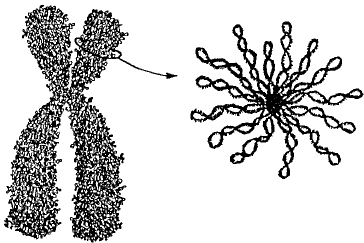Two protein complexes are primarily responsible for chromosomal spatial organization in human cell nuclei. DNA tension has an unanticipated function in this. Together with Austrian colleagues, nanoscientist Cees Dekker and his PhD candidate Roman Barth of TU Delft’s Kavli Institute of Nanoscience published their detailed visualization in Nature on April 19th, 2023.

Image Credit: Delft University of Technology
Cohesin Loops DNA
Long DNA strands in cell nuclei are neatly folded into chromosomes, which have the form of bottlebrushes, in advance of cell division, as has been known for more than a century.
Chromosomes are arranged into loops both during divisions and between them, which is crucial for controlling how genetic information is processed. Dekker and his team developed the first visual representation of how SMC protein complexes like condensin and cohesin extrude DNA loops in 2018.
CTCF Flags Have a Direction and Determine Where a Loop Begins and Ends
It was discovered that the location of loops around the genome is significantly influenced by the DNA-binding protein CTCF.
If you think of DNA as a rope, onto which CTCF flags are pinned at two points, cohesin makes the loops from one flag to the other, but only if the CTCF is oriented correctly. Only one side of the CTCF protein is able to interact with cohesin. Then again, it doesn’t always do this, because we thought CTCF would also fail frequently. But now we have measured it. The interaction between the two proteins turns out to be much more subtle than we predicted.”
Cees Dekker, Distinguished University Professor, Molecular Biophysics, Delft University of Technology
According to PhD candidate Roman Barth, it is already commonly known in the field that CTCF and cohesin cooperate to create loop boundaries.
In every conference presentation I attended in the past year, the basic premise was that the cohesin complex extrudes loops between correctly oriented CTCF molecules. But nobody had ever seen in detail how that happens. We have now been able to visualize the essence of this.”
Roman Barth, PhD Student, Kavli Institute of Nanoscience
And DNA Tension Plays a Surprising Role in This
The proteins were successfully made available in their pure form by team members from Jan-Michael Peters’ lab at the Institute of Molecular Pathology in Vienna. A surface was covered with the two ends of a DNA molecule, which were stained with a fluorescent dye along with the proteins. The researchers subsequently found an unexpected finding, according to Dekker.
Dekker added, “In the data, Roman discovered that it made a difference whether the DNA strand was very loose or under tension. Without tension, cohesin often ignored the CTCF flag, even if correctly oriented, but when the DNA was under more tension, the CTCF acted as a perfect barrier. So, under the influence of DNA tension, CTCF becomes like a smart traffic light, allowing cohesin to pass or not, depending on the local traffic situation.”
Cohesin can either stop or continue when it comes into contact with a CTCF protein. The researchers discovered that it has the ability to reverse or even disappear completely. The subsequent issues that Dekker seeks to address are how and why this occurs.
Source:
Journal reference:
Davidson, I. F., et al. (2023). CTCF is a DNA-tension-dependent barrier to cohesin-mediated loop extrusion. Nature. doi.org/10.1038/s41586-023-05961-5